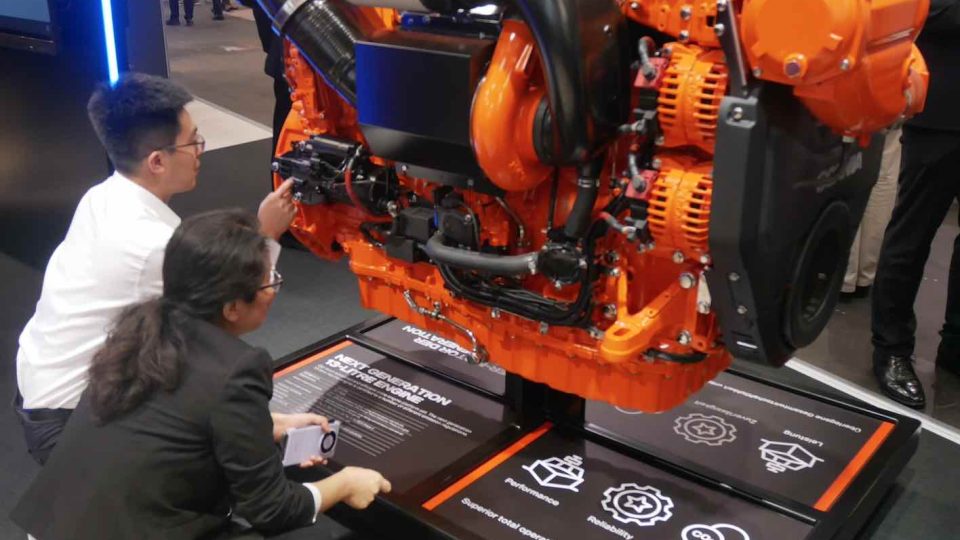Scania Next Generation DC13: the Diesel of the Year in the quarry with Perlini Dumpers
The Scania Next Generation DC13 has what it takes to respond to the needs of the muscle applications of that ecosystem. As Dario Poltronieri, project manager of Perlini explains, there are two main needs: “increase power and reduce consumption”.

The Scania DC13 has so far exercised its charms on some earthmoving manufacturers who need no introduction. In the first place Doosan, passed under the Hyundai banner, with the Develon brand, for example with the DX530LC-7 wheeled excavator and with the 40-ton rigid-frame dump trucks, the DA40. Speaking of dumpers, there is another name, Perlini, which has reappeared on the quarries stage for some years now, which has embraced the Scania cause, 12.7 liters included.
Perlini, before and after
In 2020, in the midst of the pandemic, we interviewed Dario Poltronieri, project manager of Perlini. Among other things, he told us: “The support from Scania has been excellent, as has the integration of the engine. We immediately realized that there was the right humus to do an excellent job, and the response of the engines in the first tests, with the dump trucks working in particularly challenging conditions, on construction sites with slopes of up to 18%. They have given results even better than expected”. We thought we’d subject the Griffon to the litmus test of re-examination. Three years later, we then contacted Poltronieri, who made his debut as follows: “For us Scania represented and still represents a source of pride for having received the credibility license from such a prestigious group. Whenever we had any kind of need, we received an adequate response”.
Let’s go back to the origins of this report. Can you summarize the stages of your journey?
“The collaboration with Scania began in 2018 and has allowed us to develop our new vehicles, because current regulations have forced us to use Stage V approved engines. For the 40-ton machine, the DP405, we used the DC13 Stage V, for the 70 ton, the DP705, we instead opted for the DC16. Subsequently the company grew and that utopia espoused by Scania became reality. We have received the first orders from non-European markets. We therefore also relied on Scania for Stage II applications. The last non-issued fleet consists of 8 70-ton machines, shipped to Cuba last May. About a year and a half ago, Perlini decided to build a smaller 26.5 ton machine, the DP265, which mounts the Scania DC9. We presented it first at Bauma Monaco, then at Samoter, with one difference. The months between the two events were used to carry out a test inside a Fassa Bortolo construction site, at the Gavardo quarry, in the province of Brescia, Italy. It is a totally digitized machine, we act remotely on all the parameters”. Poltronieri adds a couple of captions on the engine and hybridisation. “The DC9 is a very performing engine and has given us amazing results, both in terms of power and reduced consumption. Scania has given birth to hybrid applications, whose developments we await, to apply them on the prototype that we conceived in just 8 months. We are in no hurry. The reference markets are not ready to receive that type of machine. At the moment, we are not interested in solutions other than diesel, because the market does not require them”.
What if you could mention the names of those who contributed to the success of this partnership?
“I would. All this was in fact possible thanks to the technological supports provided by Dario Pitassi and the commercial ones by Riccardo Moraglia. Small companies like ours are dynamic and require just as much flexibility. If I think of how many Saturdays spent with Pitassi… To get approval, you have to do things right on the intake and exhaust lines”.
Considering these assumptions, could there be room for the Scania Next Generation DC13?
“Starting from the obvious consideration that we will first have to see it in the field, the answer is ‘in theory, yes’. We follow two directions: increase power and reduce consumption (and the Diesel of the Year 2023 meets both requirements, ed). We must ensure that the vehicle fully expresses the rated power. The engineer has the task of providing a high-performance unit, we have the task of using components that enhance the engine. Let me give you an example: in 2019 a former Perlini customer contacted us, who had rented a competitor’s car. Months later he complained that the consumption did not correspond to what was declared. So I pointed out to him that consumption is over the counter, and must be contextualised. If you have a 5% climb with 4 water drainage bumps, Perlini suspensions come to your rescue because they resist without jolts. Their mechanics allow you to maintain a high speed even with a disconnected road surface. Another car could induce the driver to stop before the hump, to avoid hitting the kidneys, and when you set off again with a full load, consumption soars”.
Poltronieri concludes with a reflection on the market. “Earthmoving is skeptical of the more extreme applications, for fear that problems may arise along the way”.








